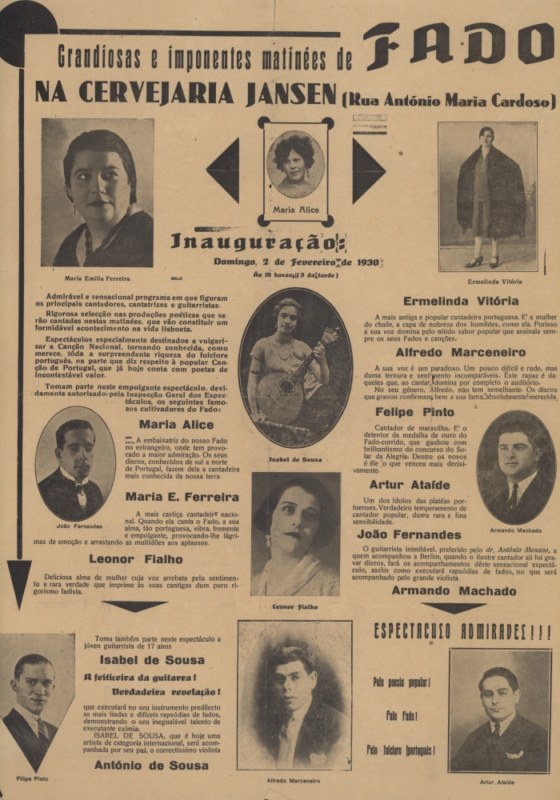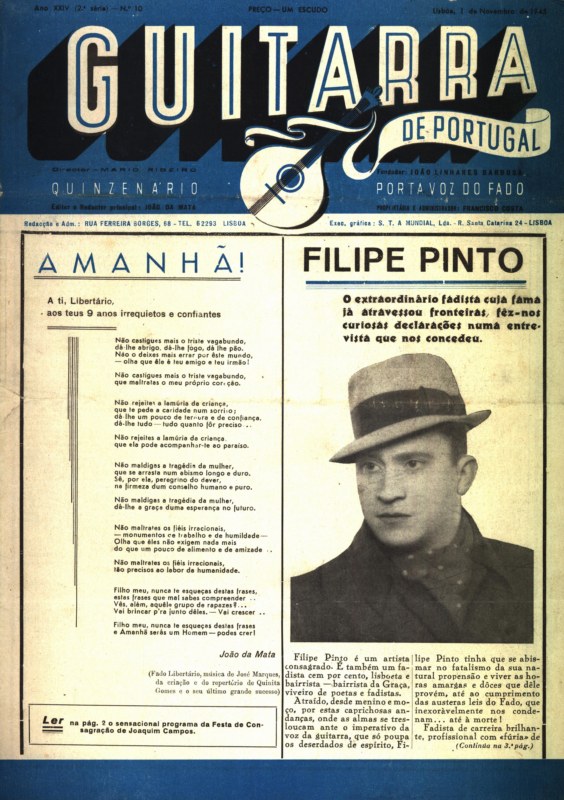Know more:
Filipe Pinto
(N. 2 May, 1905 - M. 7 February, 1968)Filipe Pinto, whose full name was Filipe de Almeida Pinto, was born on Barbadinhos, Santa Engrácia, Lisbon, on May 2, 1905. He was the son of Henrique de Almeida Pinto and Maria da Silva.
According to his own words: "those days it was on Barbadinhos that the late Rosa Sapateiro, the Vilanova brothers or Aguiar Barata - who are still alive fortunately - used to sing their fados." (“Guitarra de Portugal, 18 de Junho de 1932”).
He worked as lithographer and began singing the fado at age 15, according to the interview he gave to “Guitarra de Portugal” and was front page on June 18, 1932:
"Ten years ago the Sociedades de Recreio used to organise charity poetry meetings. Bringuel was the best. He was a marvellous singer: to hear him sing was indeed such a pleasure for me. I did my first shows back then. Shortly after (1922) I was singing at “Sempre Unidos”, on Rua Vale de Santo António, and in a neighbourhood club where another great singer - Joaquim Campos – was also working. I owe him the beginning of my singing career". (“Guitarra de Portugal, 18 de Junho de 1932”)
In May 1927 Filipe Pinto receives his artistic card and stands out as one of the audiences’ favourite artist not only for his excellent voice but also for his extraordinary personality.
He had a love affair with the young singer Cecília de Almeida – the famous “Cotovia do Bairro Alto” -, who lived on Rua do Norte, in Bairro Alto, and who died on February 1, 1932.
He joined the cast of “Companhia Típica Portuguesa da Embaixada do Fado”, with Maria do Carmo, Maria do Carmo Torres, Branca Saldanha, Joaquim Pimentel, Armandinho (Portuguese guitar), and Santos Moreira (guitar), directed by Alberto Reis. In August 1934 they left for a Brazilian tour (“Guitarra de Portugal, 21 de Agosto de 1934”). In June 1935 they did a show in Buenos Aires.
Back to Portugal, Filipe Pinto worked at “Salão Artístico de Fados” and “Cervejaria Vitória”, and in several shows on Emissora Nacional. He also worked at “Café Mondego”, “”Retiro da Severa”, and “Solar da Alegria”. He was artistic director of “Solar da Alegria” during the end of the 1930s, the same venue where he won a gold medal and an extraordinary ovation in a Fado Corrido competition some years before.
He continued his career working at several fado houses (casas de fado), namely “Luso”, “Adega Mesquita”, “Márcia Condessa”, “Toca”, “Viela”, “Mãe Preta”, and “Canto do Camões”, among many others.
In 1945 he was mentioned as “an outstanding professional with an amateur heart fado singer who is always present where fado is…” Filipe Pinto became one of the most influential personalities of the milieu. As an artistic agent (“Café Monumental” (1945) and “Café Luso” (1946)), he discovered and introduced new talents, and organised tribute events, as the one held on January 1948 at Café Luso to celebrate Alfredo Marceneiro as Rei do Fado (King of Fado).
Filipe Pinto was known as " Marialva do Fado" due to the peculiar way he used to dress.
On November 29, 1962, a tribute was held in the old Cinema Tivoli with many artists as Alfredo Marceneiro, Fernando Farinha, Max, Artur Ribeiro, Ilídio dos Santos, Lucília do Carmo, and Martinho D´Assunção, among many others.
He died in Lisbon in 1968.
Source:
“Guitarra de Portugal”, June 18, 1932;
“Canção do Sul”, September 1, 1940;
“Guitarra de Portugal”, November 1, 1945;
Machado, A. Victor (1937), “Ídolos do Fado”, Lisboa, Tipografia Gonçalves;
-
Minha Mãe Foi Cigarreira Filipe Pinto (D.R. / Fado Meia Noite estilo Filipe Pinto)

